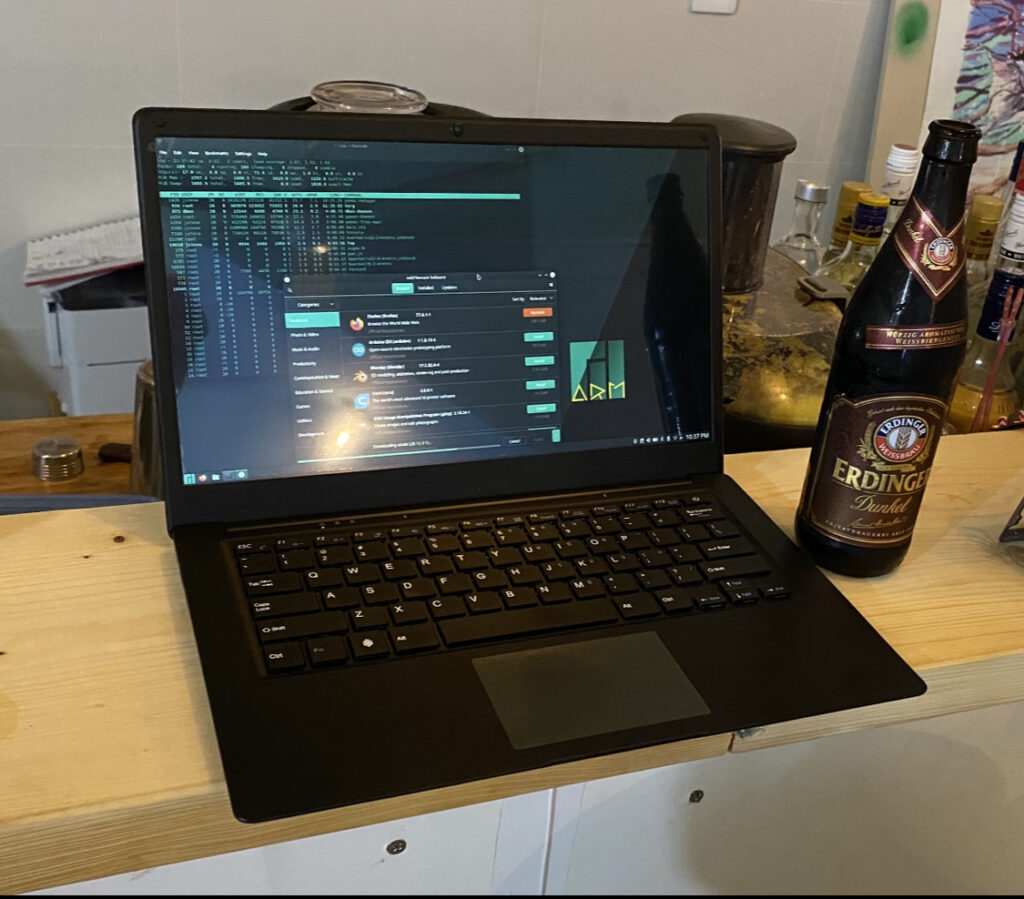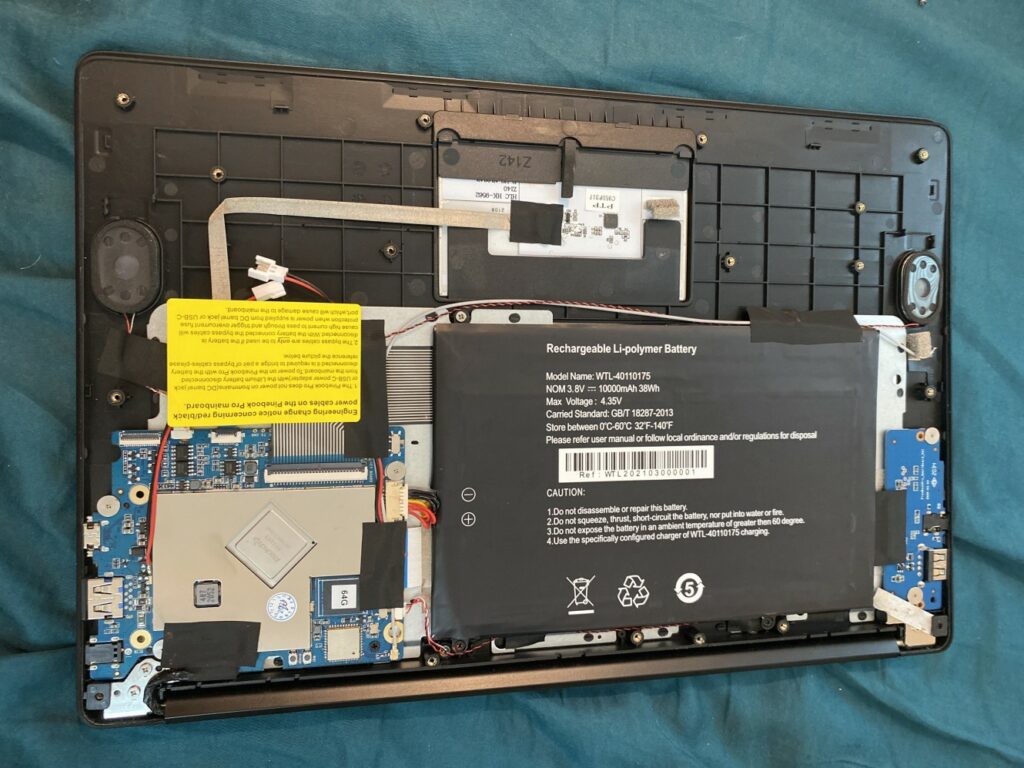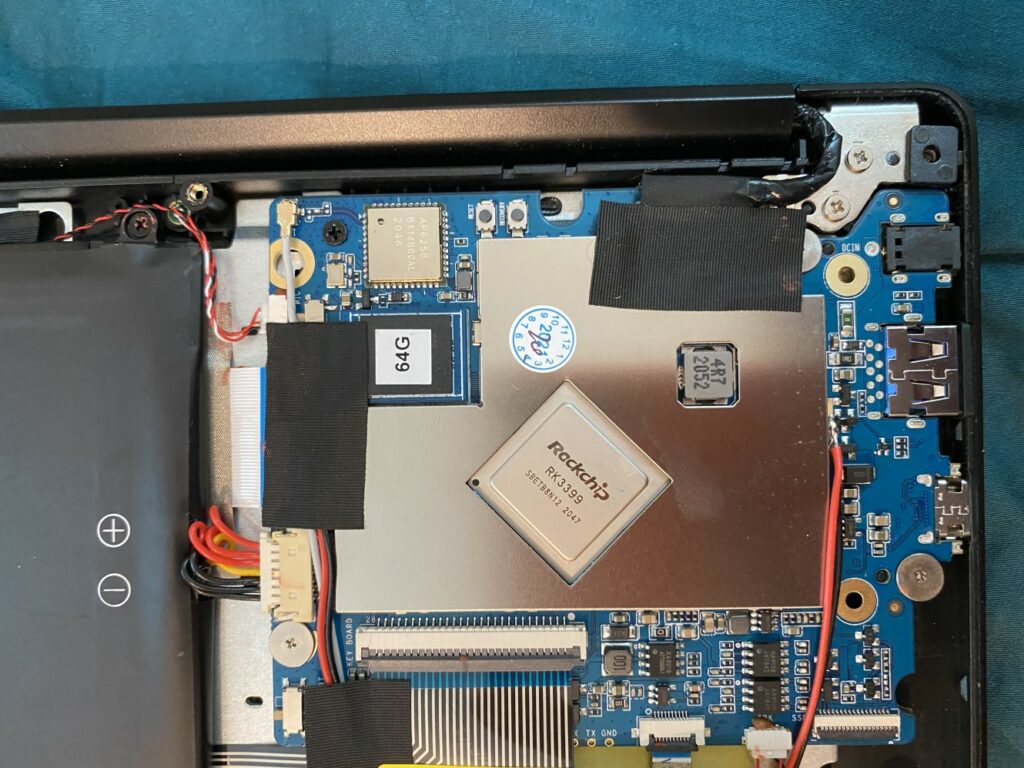
So yes, it’s most certainly built from a MacBook Air looking frame. But it’s not the same build materials, which of course is to be expected as these are far cheaper. Unlike the other ARM book I have, this one doesn’t have a GPRS modem, and as of this moment doesn’t natively run Windows. Which with it’s paltry 4GB of RAM and 64GB of disk space is just as well.
adding a 32bit runtime
Just as the MIPS64 had it’s weirdisims, the ARM64 is in the same seat. I didn’t see anything all that clear on Manjaro, and 32bit, at the same time debootstrap is available in the repo, allowing you to quickly install a 32bit Debian userland to chroot into. It’s pretty much the same steps as before, with the only real change being to use the armhf processor family giving a 32bit tree.
Maybe it’s my overall familiarity with Debian, but I find the environment far easier to deal with. Well that and of course many things just build so much nicer in 32bit mode, than 64bit mode sadly. It’s a shame that many distros don’t seem to include a matching 32bit/64bit libset but here we are.
Another plus is that Debian has far more robust mirrors world wide, and downloading components and updates is FAR faster than Manajro.
Loose clips?!
In the first week however disaster struck as I had it ‘sleeping’ one night and plugged in to charge, and when I opened the lid, I got nothing. The charging led showed RED for some reason like it was still charging, and no matter what I tried on the keyboard it just would not turn on.
Searching online didn’t give me much other than people saying that they were replacing the built in flash and didn’t seat it correctly. Did my kids or cat knock it over when I wasn’t looking? Was it on the edge of not being seated from shipping? I have no idea.

Well as much as I love opening new stuff, it was acting dead so I guess nothing to lose. That said the screws come off pretty easily but there is 2 sizes as the ones up front are super short. With the lid off you can see that the battery is 2x the size of the motherboard. And yeah of course it being ARM, its very raspberry pi – ish. And I guess it’s really no surprise.

On the mainboard there is 2 push buttons, and 2 sliding jumpers. One is hidden beneath the black tape. I hit the reset button, and slid both sliders up and down and then pressed down on the 64GB chip. I flipped it over to see if that did anything, and surprisingly it’d turn itself on!
I quickly shut it down, and screwed it back together. And I’ve been using it daily over the last week without any further issues with it powering on. Again I have no idea what was wrong but at least it seemed easy enough to open up and hit some buttons. Which brings me to the overall feel:
Build quality
It’s really hard to slam the PineBook Pro. It has incredibly lofty goals, and for the pricepoint it’s absolutely insanely good value. The body has been molded from what at best could be called an ‘inspired by the Mac Book Air’ but it’s the keyboard and trackpoint where it falls short. The keys have too much travel for their own good, and seem to twist a little giving a klunk as they don’t depress quite right. I have had issues with the arrow keys trying to play DooM via DOSBox. And I’ve become so spoilt with backlit keys, that although I know how to touchtype I still look from time to time.
The trackpoint is miserable, it’s constantly jumping the mouse (no palm detection)? and it just doesn’t glide or click ‘right’. But I know I’m being 100% unfair as I’m comparing this to a laptop that is 5x the price. I’ve written this and other stuff on the laptop and it’s just been so jumpy at times for seemingly no reason when I type it’ll jump and click at the worst possible moments.
The flip side is that FPS stuff is impossible as the keyboard and trackpoint won’t deliberately work at the same time. And I have no idea how to go about dealing with that. I guess use an external mouse.
Another stupid low point is the speakers. They are so tinny which I guess is to be expected, but they are so quite. I guess I should play test tones, and get some app to measure dB, but comparing it to anything else again just seems so unfair.
That said the screen is AMAZING. I had worried that the screen was going to be terrible, but no the screen is an absolute high point of the machine.
Battery life has been pretty good, and from opening it up, it’s no surprise as it does have a massive battery. They do include clips to bypass the battery all together if you want to run it from DC mains 100%. The only issue I have had with battery life is that Manjaro doesn’t seem to have hibernation support. And many times I put it to sleep when I go to sleep it’ll wake up with zero percent remaining. I don’t see that as a fault of the physical build, rather the OS.
Software and FSF flailings?
I don’t know much about Manjaro but it’s default setup sure feels a lot like the way Debian felt when they were under pressure to keep all non-free stuff segregated and partitioned away from users. The problem as it’s always been is that popular software has almost always been commercial, especially for normal uses. Turning on Community and Contributions should really be the default setting with people who want to be FSF pure having to click the button giving normal people the best possible experience. As an old person who’s been hearing about the ‘year of the Linux desktop’ is at hand back in 1997 (Va Linux et al), and been an on and off user since SLS, it’s always about the users. All the plugins and bookmarks and shared data stuff I have is on Chromium and having to hunt down how to turn it on sucked, as I was moments away from just doing the usual ‘user’ thing of wiping the install because I can’t find an app.
Distro shopping has been the worst thing to plague Linux since it was apparent that Linus wasn’t going to bless us a userland, unlike BSD. I know some see it as a strength but it’s always been such a critical weakness for the user. Oddly enough the circle has come around to bite enough people that Docker is a thing to deal with dependency and distro hell.
Games!
Well without a doubt visit astr0baby’s blog and enjoy some good hand holding to get a bunch of open stuff built. It’s toally worth it. And incredible to play 64bit Duke Nukem 3D!
Is it worth it?
Well if you want non x86 on the go, the price simply cannot be beat. However the default Linux install is alien to me, but I’m trying to learn to deal with it. And of course the weird power on issue really precludes this from normal people. I’d recommend it to anyone comfortable with Linux and a screwdriver. If you are 100% hardware focused it’s a laptop, no GPIO so it’s going to be a little bit of a bummer. If you are scared of opening it up, you may find like I did that you very well might have to. However for anyone in the middle absolutely.
“Normies” this isn’t the laptop you want. .. I’d say “yet” as I’m sure that build quality will only improve, just as software will hopefully get a bit more friendly for adding stuff like Chrome (what a mission to get it installed!).
Final ramblings
Years ago in college we joked that 30 years in the future you could get a quad processor Dec Alpha as a bundle in with a box of cereal. That a computer would be an impulse purchase at the supermarket. It seemed so laughable but a given as manufacturing and acceptance of that internet thing was a given. But that was the future from 30 years ago.
The future is now!

You definitely need to try Debian on it, there’s an unofficial installer that uses debootstrap and prepares a MicroSD with debian testing on it; you’ll feel at home with it.
It’s most likely what I’ll end up doing. It’s too harsh an environment to really conform to.
I’ve had my Pinebook Pro for nearly a year and can only say that it seriously grows on you. I found Manjaro a bit strange but I think that was as much the KDE/Plasma interface as the OS itself. I think there’s an XFCE version too and I need to try it to make a fair comparison as that’s a DE I’ve used a lot.
The trackpad started by being very annoying but there’s a section on it in the Manjaro Pinebook notes and you can tinker with the settings and get it pretty smooth. In particular I like the scroll feature from running your finger along the side edge of the trackpad.
Overall I think the laptop is amazing value and very usable. I find I’m using it ever more frequently because it just seems that bit more convenient to pick up and put down – and the screen makes working on it really pleasant.
Good luck with the rest of the first 12 months!
Thanks! I’m still amazed at the screen, they warn of poor performance, dead pixels but wow it seems great, although I haven’t done any refresh testing with a 100fps camera.. but it’s just so incredibly high resolution and clear!
For me the annoyance seems to be the 4gb of ram and pockey processor. But again it’s that price point. Browsers are just overall terrible all consuming singing and dancing apps.
I need to upgrade the storage but all that means is that I’m using it more. It’s incredible value, unlike the loongson MIPS that is more of a curiosity, as little endian mips gets no love and word is China is moving all RISC-V so MIPS may very well die with the lawyers that are fighting hard to prevent people from using MIPS.
Hey Neozeed, long time reader and also PBP owner. Wanted to let you know there’s a firmware update for the touchpad that fixes pretty much all of the issues you mentioned:
https://forum.pine64.org/showthread.php?tid=14531
https://github.com/dragan-simic/pinebook-pro-keyboard-updater
Make SURE you follow the directions, and if you’re still booting manjaro instead of switching to debian, you’ll need an external USB keyboard because it deactivates the internal keyboard as well for some reason (but only in manjaro). Takes 3 minutes and the improvements are top notch.
sounds awesome! I have a keyboard somewhere around here… I just need to get time without my kids yelling and acting like wild animals… lol
This is an old story but I wanted to share it.
I got my pinebook last year for a coffee.
My friend said It is a peace of junk.
After one year it is my go to solution for writing emails or just learning some stuff.
It has some limitations but I can live without spotify and netflix XD
Beside that I have a chromebook tablet as well. (Lenovo ideapad 3)
I installed an SSD as well and created services to manage the A72 cores for battery time. (The SSD was a little bit strange in the start but after reading about it is now fine)
Since then it is running fine with armbian.
😉